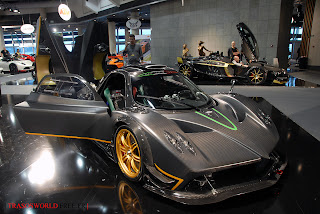This is the Pagani Zonda R.....and I LOVE it, but I also hate it.
The Zonda R debuted at the Geneva Motor Show 2007, using the 6.0 litre V12 engine sourced from the race version of the Mercedes-Benz CLK-GTR. The Zonda R's competition lies with track-biased cars such as the Ferrari FXX and Maserati MC12 Corsa rather than the original Zonda's road competitors as it is not road-homologated.
Despite sharing much of the Zonda's shape, the R is almost entirely new, sharing only 10% of the Zonda F's components. It has been obliquely suggested by Horacio Pagani that this car is a testbed chassis for certain components of the Zonda's replacement (in the same vein as the Ferrari 288 GTO Evoluzione and the successive F40) and that the Zonda R accurately reflects some of the Zonda's successor's features.
The central carbon chassis incorporates a roll cage and a rubber racing fuel cell with 4 fuel pumps and quick refuel filler cap, similar to GT race cars. The wheelbase has been increased by 47 mm (1.9 in) to increase stability. The front and rear subframes are brand-new, built to accommodate new suspension geometry, and produced in Avional. The slick-shod wheels are new forged-magnesium center-lock models, which in conjunction with on-board pneumatic airjacks (again, like the FXX) allow rapid change of the entire wheel assemblies.
The car senses, displays and logs information about the amount of downforce that is generated at each wheel at all times. It is thought that this system will enable owners to adjust set-up according to track conditions and to improve their cornering technique.
In addition to the wheelbase increase (47 mm), overall length has increased by 394 mm (15.5 in) and track by 50 mm (2.0 in). The bodywork and aerodynamics have been altered to offer maximum downforce, featuring a longer front bonnet with flaps, a closed underbody and a new rear overhang with adjustable rear wing and race-derived diffuser. These are intended to translate into increased aerodynamic efficiency and downforce for maximum cornering speed. It is also noted that the car's new rear bodywork is minimal in the extreme, being composed mostly of vent. This is thought to be symptomatic of the need to keep the engine cool enough, even under hard track use. Again, this is similar to the gutted bodywork of the Ferrari FXX Evoluzione.
Output has increased to 740 bhp (552 kW; 750 PS) at 8500 rpm and 525 lb·ft (712 N·m) of torque. A lightweight carbon fibre high performance intake system, racing multiple disc centered clutch and Formula One-style exhaust system, hydroformed in Inconel 625 and ceramic coated for optimal heat dissipation, have been added. The engine is combined with a 6-speed transverse-mounted manual sequential synchronized gearbox. Engine was built by Mercedes-AMG. ( Yes I really know what all that means )
The car's interior is spartan reflecting the car's racetrack aspirations and intended home, and features bespoke seats, customized to the driver to offer maximum support. As before, the Digitek instrumentation provides essential information and the sophisticated telemetry allows a variety of sensors to monitor numerous aspects of the car.
The problem is that you can't use it unless you own your own race track. It's not street legal and it doesn't meet any racing series criteria. Its basically a big, fast, powerful, expensive millionairs toy.... but who gives a crap? its awesome and I need one in my life.








No comments:
Post a Comment